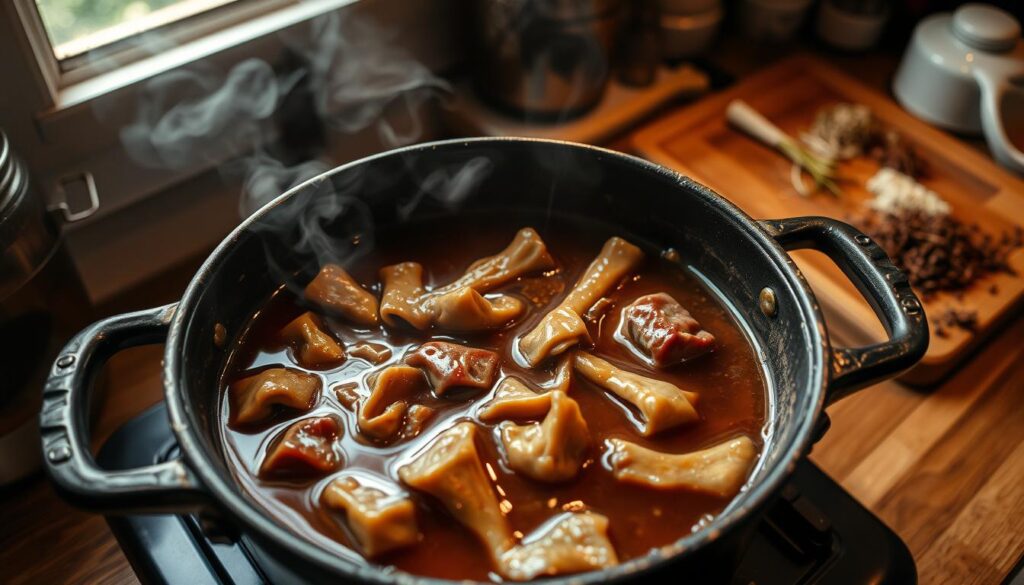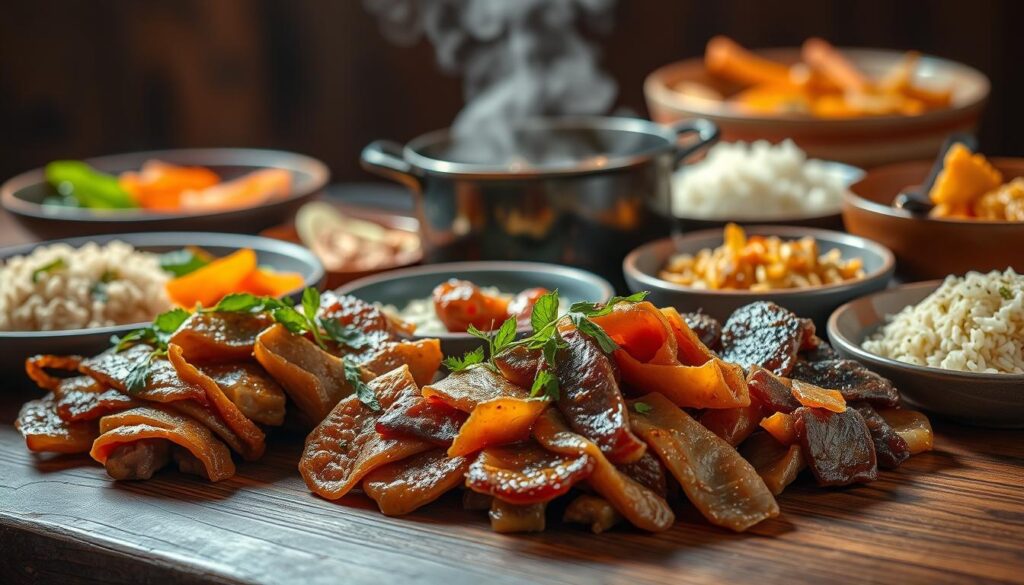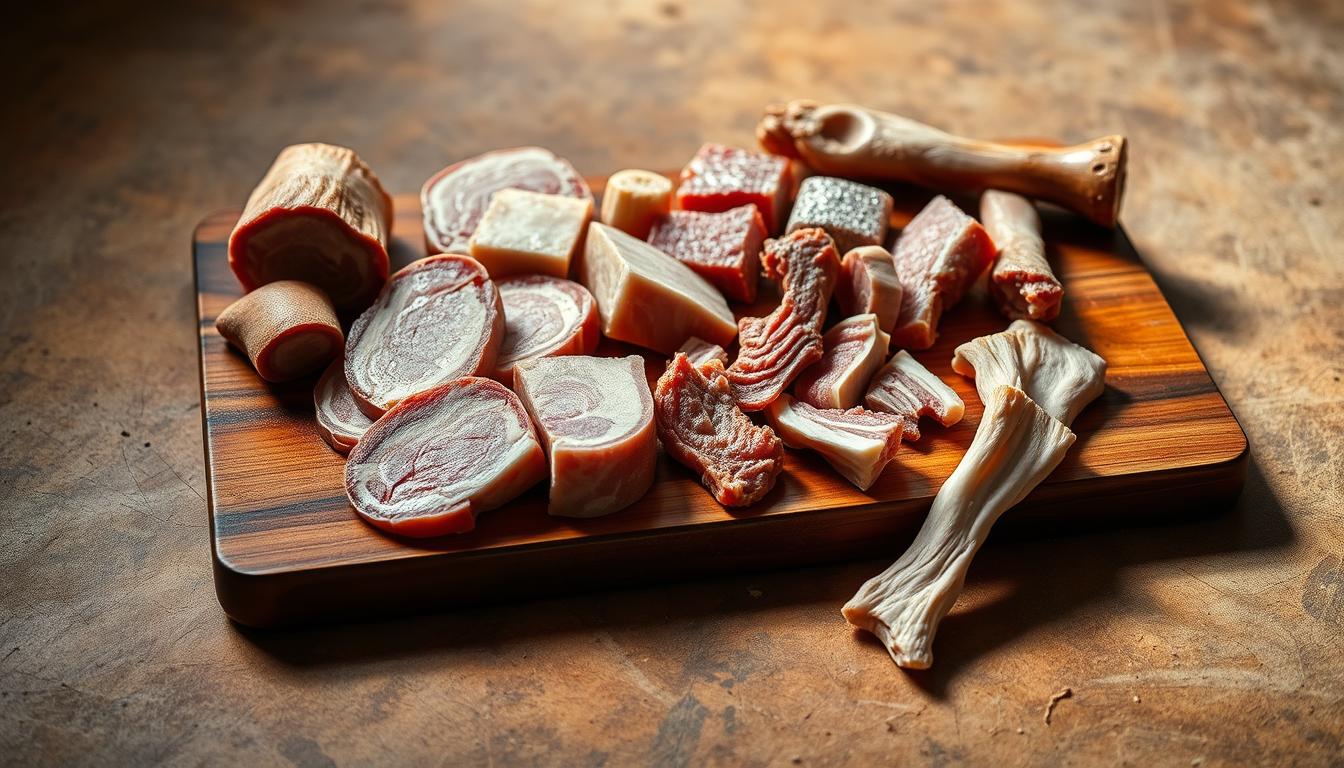Every culinary adventure starts with a challenge, and cooking beef tendon is no exception. My first attempt was a kitchen experiment that turned a tough cut into a mouthwatering delicacy. If you’ve ever wondered how to cook beef tendon, you’re in for a delightful journey of flavor and technique.
Beef tendon might seem intimidating, but with the right approach, you can master this unique ingredient. Whether you’re a home cook or an aspiring chef, this beef tendon recipe guide will walk you through every step. You’ll learn how to create tender, delicious dishes that will impress your family and friends.
Cooking beef tendons doesn’t have to be complicated. With a pressure cooker, you can transform these tough cuts into a succulent meal in just 20 minutes. Our comprehensive guide will show you how to cook beef tendon with confidence and skill.
Key Takeaways
- Pressure cookers can reduce cooking time to just 20 minutes
- Beef tendons are rich in protein and essential minerals
- Proper selection and preparation are crucial for tender results
- Multiple cooking methods offer versatile preparation options
- Seasoning can dramatically enhance beef tendon flavor
Understanding Beef Tendon Basics
Beef tendons are a fascinating ingredient in cooking. They are rich in protein and change a lot when cooked. This makes them a great choice for many dishes.
Learning about beef tendons means knowing their key traits and health benefits. These tissues are not just tough. They are also full of important nutrients.
Types of Beef Tendons
There are different types of beef tendons, each with its own features:
- Fresh whole tendons – found in butcher shops
- Cleaned and trimmed tendons from specialty meat suppliers
- Pre-packaged tendons in Asian grocery stores
Nutritional Benefits and Properties
Beef tendons are very nutritious. They are high in protein and have lots of collagen. Collagen is good for your joints and skin.
| Nutrient | Quantity per 100g |
|---|---|
| Protein | 17.5g |
| Collagen | High concentration |
| Iron | 1.2mg |
| Zinc | 2.5mg |
“Beef tendons transform from tough to tender with proper cooking techniques.”
Where to Buy Quality Tendons
Looking for quality beef tendons? Here are some places to check:
- Local butcher shops specializing in beef cuts
- Asian grocery stores with fresh meat sections
- Specialty meat markets
- Online meat suppliers with premium selections
Knowing the basics of beef tendons helps you choose, prepare, and cook them well.
Essential Kitchen Tools for Tendon Preparation
Preparing beef tendon needs special kitchen tools for success. The right tools make cooking easier and faster. They help you follow your beef tendon cooking tips better.
Here are the key tools you’ll need for beef tendon preparation:
- Pressure Cooker: Essential for quick cooking
- Sharp Chef’s Knife for precise trimming
- Sturdy Cutting Board
- Colander for draining and rinsing
- Measuring Cups and Spoons
- Large Storage Containers
Your pressure cooker is the most important tool. It cuts cooking time from hours to just 1 hour and 15 minutes. This makes cooking faster and your tendons tender and delicious.
Pro Tip: Always check your pressure cooker’s maximum fill line to ensure safe cooking and prevent overflow.
Quality tools make cooking beef tendon easier and more fun. Each tool has a special role in preparing, cooking, and storing your tendons perfectly.
Selecting and Quality Check Guidelines
Starting with the best meat is key to making great beef tendon dishes. Knowing how to pick and check beef tendons is important. It helps you make tasty dishes.
- Clean, uniform color without discoloration
- Firm texture with slight translucency
- Minimal excessive liquid or moisture
- No unusual or off-putting odors
Visual Indicators of Fresh Tendons
Fresh beef tendons should look slightly glossy. They should be light beige to pale pink. Stay away from tendons with dark spots or greenish tints. The surface should feel smooth and springy.
Storage and Shelf Life
| Storage Method | Refrigerated | Frozen |
|---|---|---|
| Raw Beef Tendons | 1-2 days | Up to 3 months |
| Cooked Beef Tendons | 3-4 days | Up to 2 months |
Pre-cooking Preparation Steps
Before cooking, follow these steps:
- Rinse tendons under cold water
- Trim off any extra fat or connective tissue
- Pat dry with clean paper towels
- Cut into even pieces for cooking
Choosing and preparing well is crucial for tender, tasty beef tendon dishes. They will surely wow your guests.
How to Cook Beef Tendon: Step-by-Step Guide
Cooking beef tendon needs patience and the right method. It turns tough meat into a tender treat. Your recipe will be a fun journey that rewards slow cooking and prep.
- Preparation Steps:
- Clean the beef tendon under cold water
- Cut into 1-inch pieces for even cooking
- Remove any excess fat or connective tissue
- Initial Cooking Process:
- Blanch tendons in boiling water for 10-15 minutes
- Skim off any foam that rises to the surface
- Drain and rinse with cold water
The secret to perfect beef tendon is slow cooking. Most people find pressure cooking or braising best for that tender texture.
| Cooking Method | Time | Recommended Technique |
|---|---|---|
| Pressure Cooking | 40-45 minutes | High pressure, liquid-based cooking |
| Braising | 60-90 minutes | Slow simmering in flavorful liquid |
When cooking beef tendon, remember to cook low and slow. Your patience will pay off with meat that’s incredibly tender.
Pro tip: Season your beef tendon with soy sauce, Shaoxing wine, and star anise for an authentic Asian flavor.
The best beef tendon recipe needs careful attention to cooking time and temperature. Aim for a soft, gelatinous texture that melts in your mouth. This usually takes about 1 hour of steady cooking.
Quick Pressure Cooking Method
Cooking beef tendon doesn’t have to take a long time. Pressure cooking is a quick way to make this tough meat tender and delicious in just a few minutes.
Pressure cooking is a top choice for making the best beef tendon recipes. It cuts down cooking time to 15-20 minutes. This makes it perfect for busy home cooks who want to save time without losing flavor.
Pressure Cooker Settings and Timing
To get the best results with beef tendon, follow these steps:
- Set pressure cooker to high pressure
- Cook for 15-20 minutes depending on tendon size
- Allow natural pressure release for 10-15 minutes
- Check tenderness before serving
Safety Precautions
Pressure cooking needs careful attention to avoid accidents. Always ensure your pressure cooker is in excellent condition and follow the manufacturer’s instructions carefully.
“The key to perfect beef tendon is patience and precise temperature control.” – Culinary Expert
Troubleshooting Common Issues
Be aware of these common problems when pressure cooking beef tendon:
- Undercooked texture: Increase cooking time by 2-3 minutes
- Dry meat: Reduce cooking time and check liquid levels
- Tough consistency: Ensure sufficient liquid and proper pressure
Getting good at pressure cooking beef tendon takes practice. Each try will help you get closer to making dishes as good as those in restaurants, right in your kitchen.
Traditional Braising Techniques

Slow cooking beef tendon needs patience and the right technique. Traditional braising turns tough meat into a soft, tender treat. This is done with careful prep and low, steady heat.
The art of slow cooking beef tendon involves key steps. These steps turn a tough cut into a culinary gem. Professional chefs know that proper braising brings out amazing flavors and textures.
- Select high-quality beef tendons with minimal fat
- Clean thoroughly to remove surface impurities
- Choose complementary braising liquids
- Maintain consistent low temperature
Traditional Japanese cooking, like Shigureni, is great for slow cooking beef tendon. It cooks meat in a mix of sake, soy sauce, and sugar. This makes the meat incredibly tender.
| Cooking Stage | Duration | Temperature |
|---|---|---|
| Initial Boiling | 30 minutes | Medium heat |
| Second Boiling | 45 minutes | Low heat |
| Final Braising | 45-60 minutes | Low simmer |
Slow cooking beef tendon takes about 2 hours and 10 minutes. The result is a rich, gelatinous dish. It’s packed with collagen and deep, complex flavors that melt in your mouth.
The key to perfect beef tendon is patience and precision in your cooking technique.
Seasoning and Flavoring Options
Beef tendon dishes come alive with the right seasoning. These cuts soak up flavors, turning simple meat into culinary wonders. Learning to layer seasonings can take your best beef tendon recipes to the next level.
When cooking beef tendon dishes, try these flavor strategies. They match the unique texture and protein-rich profile:
Asian-Inspired Seasonings
- Soy sauce-based marinades
- Ginger and garlic combinations
- Mirin and rice wine infusions
- Five-spice powder blends
Western Flavor Combinations
- Rosemary and thyme herb mixtures
- Red wine reduction sauces
- Mustard and black pepper rubs
- Balsamic vinegar glazes
Essential Marinade Recipes
Creating a perfect marinade is all about balance. A classic beef tendon marinade might include:
- 1/4 cup soy sauce
- 2 tablespoons rice vinegar
- 3 minced garlic cloves
- 1 tablespoon grated ginger
- 1 teaspoon sesame oil
Marinate your beef tendons for at least 2 hours, or even better, overnight. The secret to amazing beef tendon dishes is patience and careful seasoning.
Testing for Doneness and Texture
Cooking beef tendon right is all about watching closely and using the right techniques. It’s important to know how to check if it’s done to avoid it being too hard or too soft.
Visual signs are key to seeing how your beef tendons are cooking. Keep an eye out for these important signs:
- Color transformation from dark to light brown
- Increased translucency of the tendon
- Visible separation of muscle fibers
Testing the texture is a big part of cooking beef tendon well. Here are ways to check if it’s done:
- Fork Test: Stick a fork into the tendon. If it goes in easily, it’s probably ready.
- Cutting Test: Cut a small piece. It should be chewy but still tender.
Cooking times can change based on what texture you like. Here’s a quick guide:
- Firm tendons: 45-60 minutes
- Tender tendons with a bite: 60-90 minutes
- Extremely tender tendons: Over 90 minutes
Pro tip for cooking beef tendon: Be patient. Cooking it low and slow makes it tender and avoids it being rubbery. Always keep an eye on it to get the best result.
Recipe Variations and Serving Ideas
Beef tendons are incredibly versatile, turning simple ingredients into amazing dishes. Your kitchen can explore many ways to prepare them. This shows off their unique texture and rich flavor.

Trying different beef tendon recipes can boost your cooking skills. It also introduces you to flavors from around the world. Here are some tasty ways to enjoy beef tendons:
Soup and Stew Applications
Beef tendons are perfect for soups and stews. They add depth and richness to many dishes:
- Vietnamese Pho with tender beef tendon strips
- Robust Korean Gomtang bone broth
- Traditional Chinese winter melon soup
- Spicy Sichuan-style beef tendon soup
Asian Dish Incorporations
In Asian cuisine, beef tendons are a prized ingredient. They can be added to many classic dishes:
- Dim sum appetizers
- Braised meat platters
- Stir-fried noodle dishes
- Spicy cold appetizer platters
Modern Fusion Recipes
Modern chefs are making beef tendon dishes in new ways. Here are some creative ideas:
- Crispy tendon tacos
- Beef tendon sliders
- Asian-inspired barbecue glazed tendons
- Tendon-topped gourmet salads
With these versatile beef tendon recipes, you can make dishes that wow everyone. They’re perfect for impressing family and friends.
Storing and Reheating Cooked Tendons
Proper storage is key when you cook beef tendon. It keeps your leftovers fresh and tasty. Here’s how to do it right.
For refrigeration, follow these beef tendon cooking tips:
- Store cooked tendons in airtight containers
- Refrigerate within 2 hours of cooking
- Keep in the refrigerator for up to 3-4 days
Freezing is great for longer storage. Wrap tendons tightly in freezer-safe containers or heavy-duty freezer bags. They can stay good for up to 3 months in the freezer.
Reheating needs care to keep the tendons soft and flavorful:
- Thaw frozen tendons in the refrigerator overnight
- Use low heat to prevent toughening
- Add a small amount of liquid to maintain moisture
- Stir occasionally during reheating
Microwave reheating works best in short intervals. Stir between each to heat evenly. For the best results, use a steamer or gentle oven method to restore tenderness.
Tips for Perfect Tendon Dishes Every Time
Mastering beef tendon cooking takes precision and practice. These expert tips will help you make the best beef tendon recipes with confidence.
Temperature control is key when cooking beef tendons. Knowing the right cooking times can turn tough meat into a delicious dish. Different cooking times give different textures:
- 45-60 minutes: Firm and chewy tendons
- 60-90 minutes: Tender with slight bite
- 90+ minutes: Extremely tender texture
Preparation is crucial for top-notch results. Always soak beef tendons for 30-60 minutes before cooking. This step removes impurities and enhances flavor.
When using a pressure cooker, follow these important tips:
- Set cooker to high pressure
- Cook for 15-20 minutes
- Allow natural pressure release for 10-15 minutes
Seasoning can make your beef tendon dishes amazing. Try classic flavors like garlic, ginger, star anise, and cinnamon for depth and complexity.
Pro tip: Fresh beef tendons should feel firm, have a uniform color, and appear slightly translucent.
With these techniques, you’ll turn this challenging ingredient into a culinary masterpiece every time.
Conclusion
Learning to cook beef tendon opens up a world of flavors. You’ve found ways to make this tough cut tender and delicious in minutes. By trying different cooking methods and seasonings, you can make meals that taste like they’re from a restaurant.
Your skills with beef tendon recipes have grown a lot. You know how to use pressure cooking and traditional braising. Each method adds special textures and tastes that will wow your guests.
Remember, practice is key when cooking beef tendons. Start with what you’ve learned and feel free to change recipes to suit your taste. With time and creativity, you’ll make amazing beef tendon dishes that show off your cooking skills.
Cooking is a journey of discovery, and mastering beef tendon recipes is just the start. Keep exploring, tasting, and enjoying the rich flavors and textures this versatile ingredient offers.
FAQ
What are beef tendons and why are they challenging to cook?
Beef tendons are tough tissues in cattle with lots of collagen. They need slow cooking to soften and become tender. Special methods like pressure cooking or braising are needed to make them edible.
How long does it typically take to cook beef tendons?
Cooking beef tendons takes 2 to 4 hours. Pressure cooking can cut this time to 45-60 minutes. Slow cooking takes 3-4 hours to make them tender.
What are the nutritional benefits of beef tendons?
Beef tendons are full of collagen, good for joints and skin. They’re low in fat and calories but high in protein and amino acids. They’re great for joint health and natural protein.
Can I freeze beef tendons before or after cooking?
Yes, you can freeze raw or cooked beef tendons. Wrap raw ones in butcher paper or vacuum-seal. Store cooked ones in airtight containers. They can be frozen for up to 3 months.
What are the best cooking methods for beef tendons?
Pressure cooking and braising are top choices. Pressure cooking is fast, while braising adds flavor. Both methods make the tendons tender and tasty.
How can I tell when beef tendons are fully cooked?
Cooked beef tendons are tender and fork-tender. They should be gelatinous and soft. Look for shrinkage, a glossy look, and easy separation of fibers.
Are there any specific seasonings that work best with beef tendons?
Use Asian flavors like star anise, ginger, and soy sauce. Western flavors like garlic and rosemary also work well. Choose bold seasonings to enhance the tendons’ texture.
Source Links
- Master Beef Tendon Cooking in 20-minute | The Bright Food – https://www.thebrightfood.com/master-beef-tendon-cooking-in-20-minute/
- Beef Pho – https://www.allrecipes.com/recipe/57354/beef-pho/
- Beef 101: Nutrition Facts and Health Effects – https://www.healthline.com/nutrition/beef
- Blade Steak Is The Best For Braising! – https://www.thespruceeats.com/what-is-a-beef-blade-steak-995581
- 8 Simple Ways to Make Tough Meat Tender – https://www.tasteofhome.com/article/how-to-make-tough-meat-tender/?srsltid=AfmBOopXjOuuoFGtGxeY3Q1KrEVp187DXI6nfypfA7ig6Yua9yvDpvgm
- A Steaming Bowl of This Filipino Beef Soup Brings Unparalleled Comfort – https://www.seriouseats.com/beef-nilaga-filipino-beef-soup-recipe-8775569
- Optimising Beef Yield & Abattoir Profitability – https://www.fpe.net.au/abattoir-process/beef-yield/
- Meat selection – https://www.meatsandsausages.com/sausage-making/meat-selection
- A methodological review in sensory analyses of chicken meat – https://pmc.ncbi.nlm.nih.gov/articles/PMC11402291/
- Chinese Beef Stew (Authentic Recipe) – https://pupswithchopsticks.com/chinese-braised-beef-stew/
- “Pho Bo”- Traditional Vietnamese Beef Pho With Brisket Recipe — WHISKEY & BOOCH – https://www.whiskeyandbooch.com/blog/vietnamese-beef-pho-brisket
- Mi Bo Kho Recipe: Authentic Vietnamese Beef Stew with Egg Noodles – https://phobistrobarrie.com/recipe/mi-bo-kho
- The 2-Step Prep Process You Need To Cook Beef Tendon – Tasting Table – https://www.tastingtable.com/1693575/beef-tendon-what-is-it-how-to-cook/
- Sweet and Savory Caramelized Beef Tendon(Shigureni) – https://marcsrecipes.com/sweet-and-savory-caramelized-beef-tendon-shigureni/
- Braised Beef – https://www.vincenzosplate.com/braised-beef-recipe/
- Beef Tendon Powerful Benefits, Cooking Tips March 18, 2025 – https://www.dailyrecipespro.com/beef-tendon-cooking-tips-recipes/
- Hanger Steak Recipe – The Big Man’s World ® – https://thebigmansworld.com/hanger-steak/
- The Secret to Perfectly Tender Stew Meat Every Time, According to a Chef – https://www.simplyrecipes.com/how-to-get-tender-beef-stew-every-time-chef-8728496
- French Beef Stew: Homemade Pot au Feu — Simple French Cooking – https://www.simplefrenchcooking.com/recipe-entry/pot-au-feu
- Here are 6 Reasons to Drink Bone Broth – https://www.healthline.com/nutrition/bone-broth
- Vietnamese Beef Stew- “Bo Kho” Recipe + Video — WHISKEY & BOOCH – https://www.whiskeyandbooch.com/blog/vietnamese-beef-stew-bo-kho-recipe
- Featured on Tastemade: Traditional Beef Pho Bo with Oxtail – Poppa Trinh’s Pho Tai Recipe — WHISKEY & BOOCH – https://www.whiskeyandbooch.com/blog/pho-bo-with-oxtail-and-tendons-badre
- Beef tendon and bone marrow noodle soup – https://umamidays.com/beef-tendon-bone-marrow-noodle-soup/
- How to Make Beef Tendon Dog Chews: Your DIY Guide | Healthy & Natural Treats – https://discover.texasrealfood.com/waste-not-want-not/the-ultimate-guide-to-making-beef-tendon-dog-chews
- Beef Rib Finger: Know Your Meat Cuts – https://www.aussiemeat.hk/blogs/articles-and-ebooks/know-your-meat-cuts-beef-rib-finger?srsltid=AfmBOorx-KZpBfs7DAyKAmd9173aIMaK3e1MM1-t3W2FZy8kmh6OR-xm









